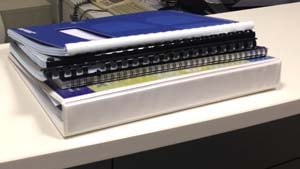
5 Steps to Fix your Standard Operating Procedures
 Over the years, I've had the honour of reading and improving stacks of standard operating procedures (SOPs).
Over the years, I've had the honour of reading and improving stacks of standard operating procedures (SOPs).
One thing I've found, without a doubt, is that every single company can improve on them. In fact, as a conservative guesstimate, 95% of the SOPs we work from are wrong. This is a major concern because it is a legal requirement to have up-to-date and consistent procedures and policies.
But even more importantly, keeping strict version control of your PowerPoint training presentations or safety operating procedures and ensuring that your trainers are all teaching the same thing is a legislative requirement. If a death were to occur at your company site, the coronial inquest would request that the training materials used on the day the person was inducted and trained be submitted for review. If there is evidence that the PowerPoint version was open and anyone could change it or that the trainer did their own version of training, then that company would be found to be non-compliant training wise.
However, the most common mistakes with policies and procedures include:
- Boring, corporate speak that is based on protecting the company, but not on engaging the worker.
- Out-of-date procedures or policies that are written in such a way that it's difficult to understand the intent.
- They are written to tick a compliance box, but not as a tool to train.
- Unattractive layout with lots of text and few visuals.
- No thought has been given to streamlining or improving procedures for efficiency.
The best policies and procedures must mirror best practices for the company which ensure staff safety, as well as productivity. Unfortunately, most have been written that are not the best practice.
The more you can ensure (and prove) that you standard operating procedures represent your best practices, the more likely you're insurer will reward you with a discount. However, you must be able to specify the steps you have taken to avoid certain risks and how these have been considered in your policies.
Essentially, here are five steps to creating best-in-class standard operating procedures:
- Written with the user in mind - Policies and procedures that have been written to engage the new trainee are always the best at training and refreshing. This means that plain language is used that is conversational, clear and friendly that actually make the employee feel respected and valued. If you need help in this area, read Transform Your Safety Communication and use the templates when updating your procedures.
- One curator - Ideally, only one person in the organisation is tasked with ensuring regular updates that are written in the same language and tone. This is an important legal requirement, but it also means that one person is always on the look out for updating procedures when they change. Ideally, they are passionate about training and are particular when it comes to writing and working out a new process step by step. This keeps the policies and procedures alive and breathing.
- Learning Management System - If you have multiple sites and more than 20 staff, you really want to have an online system that provides training and let's people know when their refresher training is due. Ideally, your online system also integrates HR and safety compliance information, as well as having a robust assessment system.
- Training videos - Without a doubt, customised training videos for your workplace are amongst the best training you can have for your staff. High quality training videos can last 5 years or more (in fact, many of our clients are still using videos we made for them over 10 years ago). The combination of both visuals and narration is an extremely powerful learning tool. Couple your training videos with online assessment and you have a first rate system for training large numbers of staff consistently all around the world.
- Full support of senior management - Once the policies and procedures are written, it's important that you have full support by the executive team to train and communicate the procedures. Without this, the policies will never be fully implemented and will just gather dust on a shelf.
According to the book, Accidents Waiting to Happen, by Rick Dalrymple, producing high quality safety operating procedures that includes best practices for reducing future claims, business risks and operational costs, will control insurance claims in the long run. This in turn ensures a profitably run company that will beat its competitors, through streamlining operational processes. In other words, spending the time getting your policies and procedures right will save you a lot of money long term - such as insurance fees, reduced claims, increased efficiency and a reduction in injuries.
What can you do to improve your standard operating procedures?

